A hot bath helps to solve a single problem in life, but personal comfort largely depends on how seriously its owner approached the bathroom repair. An important moment in the arrangement of the bathroom is the ceiling, because it is to him that the streams of hot air rise. Therefore, to the question of which ceiling to choose in the bathroom, you need to choose the right answer so that it is reliable, effective and modern.
Content
Basic requirements for the ceiling in the bathroom
It is no discovery that the bathroom is a rather damp room. In such a room, they not only take a shower or a bath, but such an incident can happen as a sudden gift from neighbors from above in the form of surging water, and while bathing in the shower you can accidentally direct a stream of water to the ceiling.
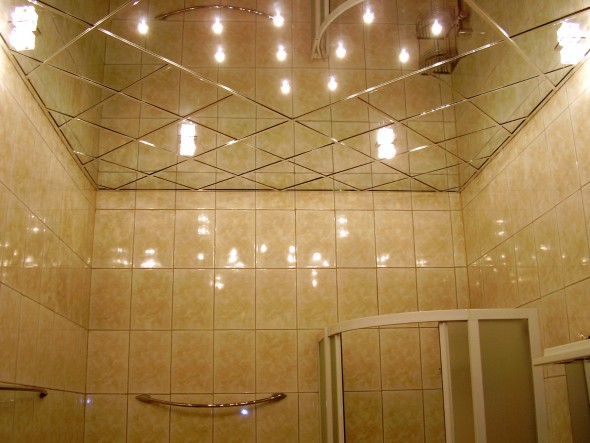
The bathroom also needs such a ceiling, which will be easy and simple to care for, for example, from time to time wipe it with a damp cloth. After all, it is worth considering that in such a small room there is also equipment and other household items that are real barriers to the frequency, but, and you should not even talk about the stepladder, there is simply nowhere to put it.
Well, in deciding on which ceiling to choose, you should not miss the aesthetic requirements, because the ceiling should be integrated into the overall bathroom interior and its style.
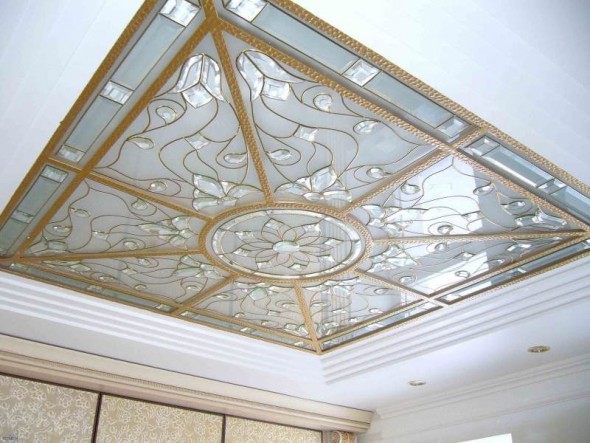
Based on the foregoing, it is worth concluding that the ceiling in the bathroom should be:
- moisture resistant;
- anticorrosive - from mold, stains, condensates and stains;
- hypoallergenic;
- with a temperature reserve - the ceiling should not be “afraid” of high temperatures;
- safe and easy to install, as well as with the ability to quickly integrate spotlights;
- Attractive and aesthetic in appearance.
Bathroom Ceiling Options
Today, the market of finishing materials offers a choice of different types of finishes that can be used to decorate the ceiling in the bathroom, but the choice largely depends on how much the landlord is willing to spend on a particular type of material.
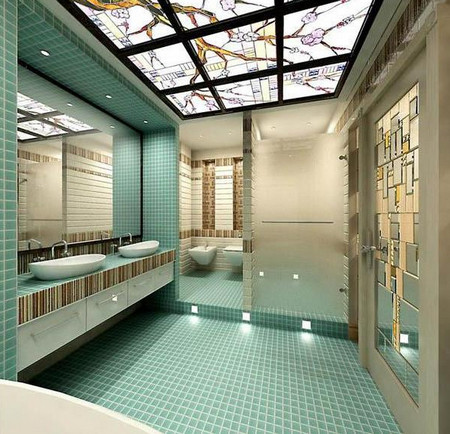
So, inexpensive finishing options include whitewashing, painting and plastering. There are options that can be attributed to the average cost - this is drywall, plastic or rail. But, and mirror ceilings or glass panels with stained-glass windows and photo prints are among the most expensive at a price.
But before deciding which ceiling to choose in the bathroom, it is worth comparing all the pros and cons of a particular material.
Plastering and whitewashing
Plaster and whitewash are the most affordable materials for decorating the ceiling surface in the bathroom. But experts do not advise plastering and whitewashing the ceiling, because such materials are poorly sensitive to high humidity and temperature. As a rule, plastered ceilings become worthless quite in the short period of operation of the room and the owners again have to spend money on their decoration, choosing more durable materials.
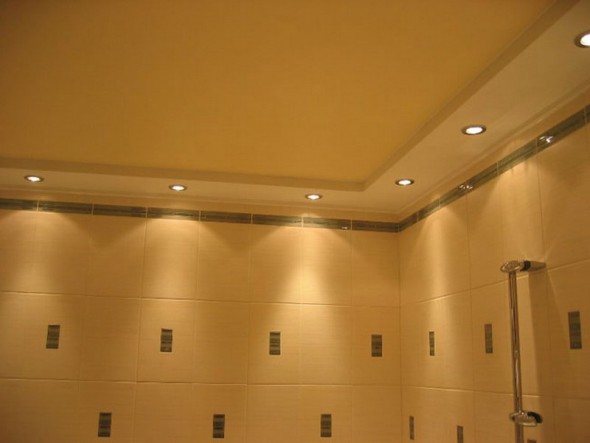
But if it so happens that there is no other choice and the ceiling has to be stuccoed and whitened, then it is worth taking into account that whitewashing can be chalky and calcareous. Cretaceous for the bathroom is immediately excluded, since chalk quickly absorbs moisture, the ceiling just crackes and the entire finish will become unusable in a short time.
Lime is more resistant to moisture, while it is able to destroy almost all harmful microorganisms, and also does not allow the appearance of mold and fungus. Also recently, lime can be purchased in different shades and thereby decorate the ceiling under the general style of the bathroom. Choosing this method of decoration, we buy only lime.
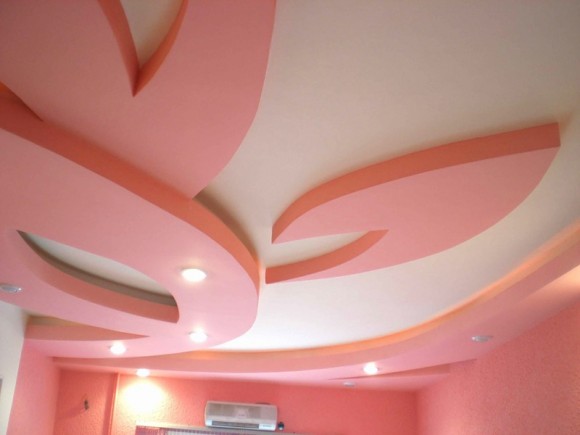
Dyeing
Another inexpensive material that many owners use to decorate the ceilings in the bathroom is paint. But this method will cause a lot of trouble if the ceiling is uneven. If there is such a defect, then it must be eliminated before painting, and this is also an unforeseen cost and time.
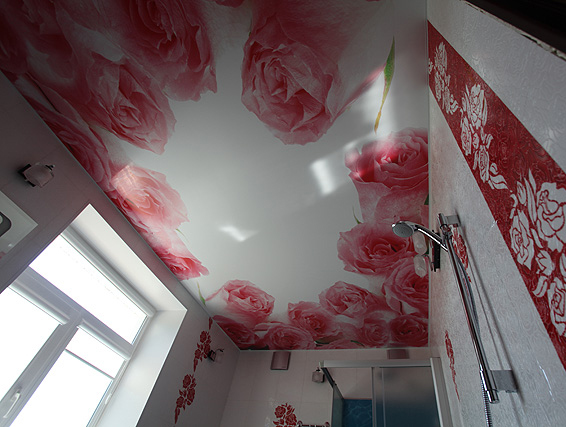
But if the ceiling does not require any serious preparation, then it is worth choosing a water dispersible or latex paint, but in no case a water-based paint, since under the influence of high humidity a painted ceiling with such a paint will quickly lose its color, and therefore an attractive appearance. But other types of paint can withstand even the most intense washing.
Before painting, the surface of the ceiling must be treated so that mold does not appear on the painted surface.
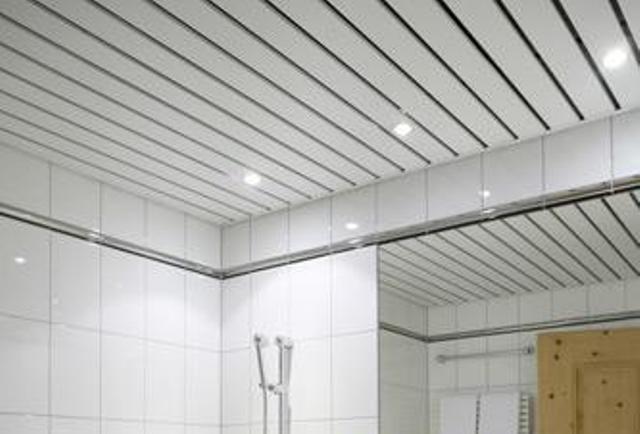
You can choose any color of paint, it all depends on personal preferences, many choose universal white, but it’s worth looking at more interesting options.
Moisture resistant wallpaper
To decorate the ceilings in the bathroom, you can choose a wallpaper, but those that are bought for gluing walls in other rooms are liquid. Previously, liquid wallpaper for bathrooms was not used often, but today they are gaining in popularity.
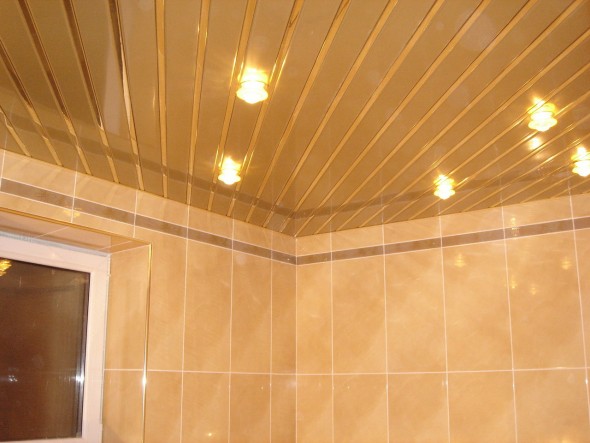
Experts do not recommend using this material for rooms with high humidity, since it is sensitive to moisture and water can simply wash them off, but if you cover the liquid wallpaper with a special colorless varnish, you can get the following advantages:
- such wallpapers are easy to apply, you don’t even have to hire specialists. Here you do not need to measure, cut, adjust, as paper wallpapers require, we just carefully study the stages of work;
- liquid wallpaper is quite plastic, and if you use different colors, then on the ceiling in the bathroom you can create a real art masterpiece;
- such wallpapers, although they are afraid of moisture, but steadily tolerate sudden changes in temperature;
- liquid wallpaper is also an excellent heat and noise insulation of the ceiling, they also do not absorb, and they themselves do not emit any smells;
- the composition of high-quality wallpapers is only natural components with antistatic properties.
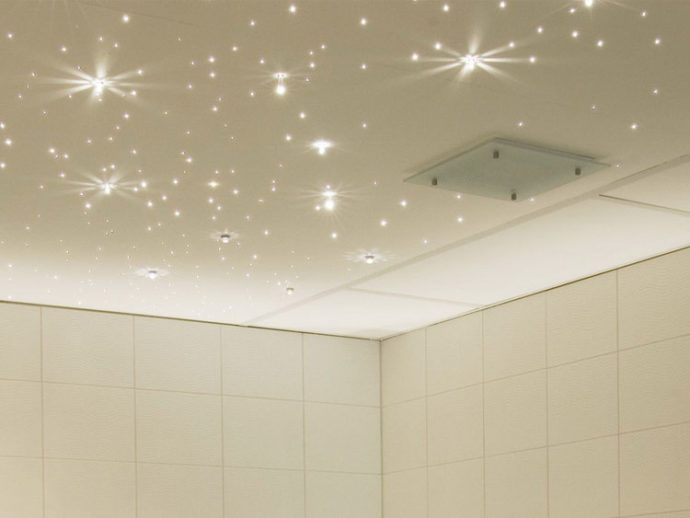
If you consider other types of wallpaper for the ceiling in the bathroom, then of course paper is definitely not suitable here, you can take vinyl. They are moisture resistant, for their gluing you do not need to align the ceiling, a variety of shades and textures will harmoniously fit the ceiling into the overall style of the interior. But in the bath with such a finish there should be good ventilation, otherwise an unpleasant odor will constantly reign in the room.
There is also moisture-proof and self-adhesive wallpaper, which differs from vinyl only in that they just need to be moistened with water and glued to the ceiling. But an interesting novelty is fiberglass, for the manufacture of which special fiberglass is used. They are strong, durable, environmentally friendly, do not allow the appearance of mold and pathogenic microorganisms.
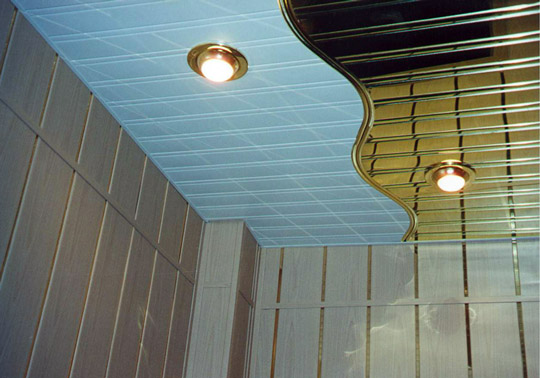
For bathrooms with a small area, you can watch vinyl murals with the image of the sky or a dome going up, this will allow you to visually expand the room.
Plastic ceiling
For little money, you can arrange a plastic ceiling in the bathroom and thereby choose a practical solution with the ability to create an atmosphere of cleanliness, comfort and respectability in the bathroom.
- low cost;
- good water and moisture resistance;
- the smooth surface of the material prevents bacteria and other harmful microorganisms from developing;
- durability;
- resistance to sudden changes in temperature, as well as to rotting, cracking and oxidation;
- quick and easy installation.
Also read:3 sqm bathroom design m without toilet with a washing machine
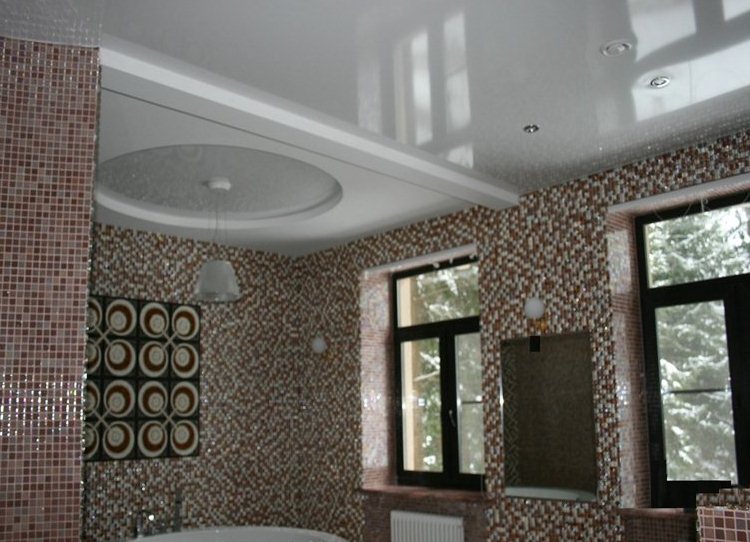
Rack ceiling
One of the most tested materials for finishing the ceiling in the bathroom is plastic battens and there are reasons for this:
- ease of installation and disassembly with the possibility of constant access to communications;
- lack of deformation from exposure to moisture, steam and condensate;
- long term of operation, from 30 to 50 years;
- environmental safety, the material does not evaporate any toxic substances even when heated;
- lack of development of pathogenic microflora, causing allergies;
- simplicity in leaving;
- the ability to install lighting fixtures.
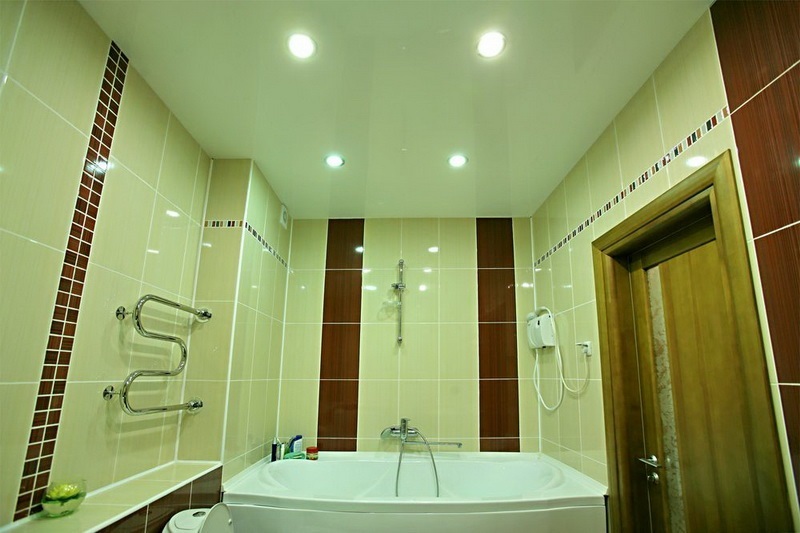
True, experts identify at the slatted ceilings and their minus, which consists in the fact that the slats are attached to the suspension system, which reduces the height of the room. Also, this kind is considered obsolete, designers have not used it in their projects for a long time.
Cassette ceiling
When answering the question of how to choose a ceiling in the bathroom, it is worth highlighting a special type of suspension design - cassette. The idea came to the French, who at one time gave the world stretch ceilings. These are cassettes that are made of different materials and are attached to a suspension structure. Typically, this is metal: galvanized steel, which is coated with special paint and aluminum, treated with bimetallic spraying or polishing, which gives the cassettes a mirror surface.
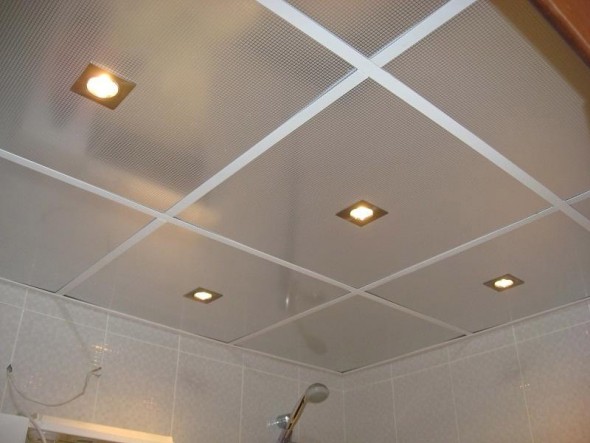
It is mirrored cassettes that are most in demand, that is, when aluminum is polished, and they can be matte and glossy, or have the color of silver or gold. It is such a ceiling decoration that can change the room beyond recognition, and due to recessed lamps, you can visually increase the space and come up with unique lighting effects.
Also read: New design ideas in apartments 2019
But there is a serious minus - on mirrored cassettes, you can see all of them stains, stains and other dirt on them at just one glance. Also, cassettes can be made of gypsum and even wood, but such materials are for bathrooms.
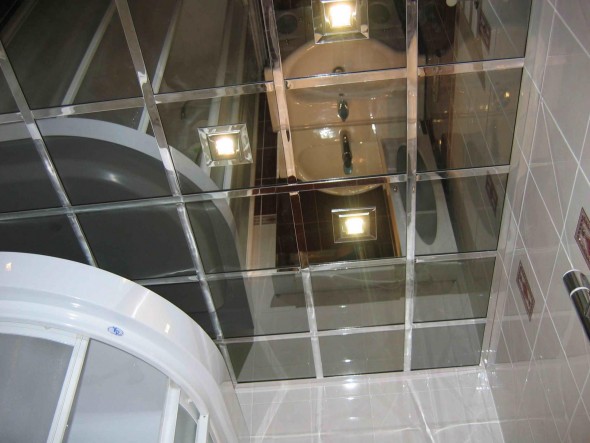
The price of a cassette ceiling directly depends on the material of manufacture, the most affordable - aluminum, expensive - wood.
The advantages of ceiling cassettes include:
- ease of installation;
- the ability to hide all defects and communications;
- simplicity of replacement of cartridges;
- resistance to mold and mildew;
- simplicity in leaving;
- long operational period;
- large selection of colors.
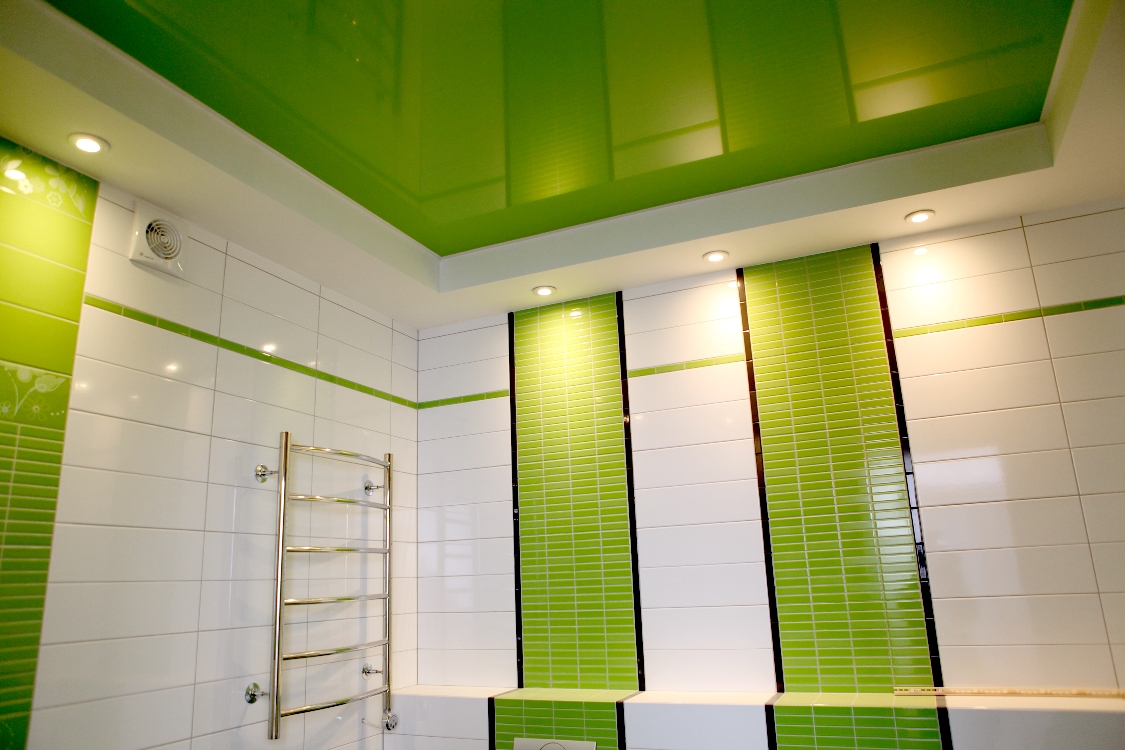
Despite all the advantages, it is better to install such ceilings in bathrooms with high walls, as the structures “steal” from 15 to 25 cm of space.
Ceiling tile
Finishing ceilings in a bathroom with ceiling tiles is a lot of controversy, so before considering such a material for decoration it is worth exploring what types of plates are, their pros and cons.
- Foam boards are the most common type of finish, the cheapest and worst of all, since its technical characteristics, as well as the appearance, leave much to be desired. A brittle, rapidly destructive material that also quickly absorbs all dirt and water.
- Extruded tile is a more durable type of ceiling tile in operation, for the manufacture of which foam polystyrene mass is used, it is stamped, coated with a protective film or painted. The advantages include: versatility, ease of installation, the ability to operate in rooms with high humidity, as well as a variety of appearance.
- Injection - polystyrene foam is also used for this type of ceiling plates, it is only melted, and then it is poured into special forms. In appearance, they are ahead of extruded plates, but in terms of strength they are slightly inferior to them.
- Plastic - this type of finish will allow you to firmly, expressively and for a long time draw up the ceiling in the bathroom.Unlike other materials, it not only easily tolerates humidity, but is also easy to clean from any dirt and makes it possible to create beautiful lighting in the room due to built-in lighting.
- Gypsum - from the point of view of designers, this is a chic finish, but not for the bathroom, since such material does not tolerate moisture.
- Ceramic - you can rarely find such tiles on the ceiling, but you can use, most importantly, buy high-strength special glue.
Also read: Apartment design in the style of modern classic
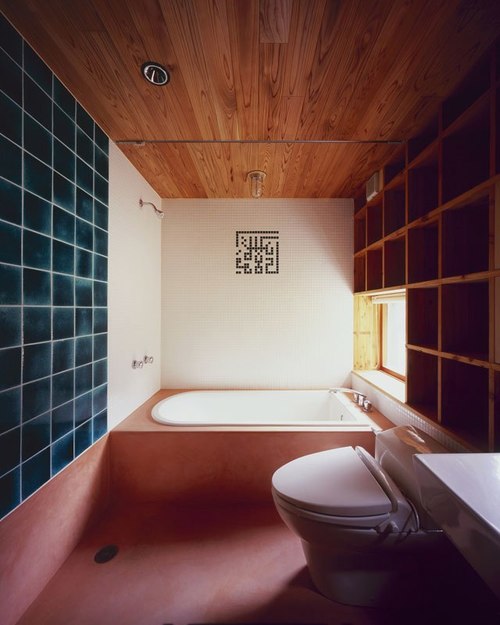
Drywall
Drywall is often used to decorate rooms, including bathrooms. The advantages of this material include:
- high ones showed sound insulation and moisture resistance, gypsum board can be used indoors even with a 90% humidity indicator;
- only natural components are used for the manufacture of the material, which means that it is absolutely safe for human health;
- drywall is ideal for uneven surfaces, allows you to hide all defects;
- simple and quick installation;
- relatively low cost.
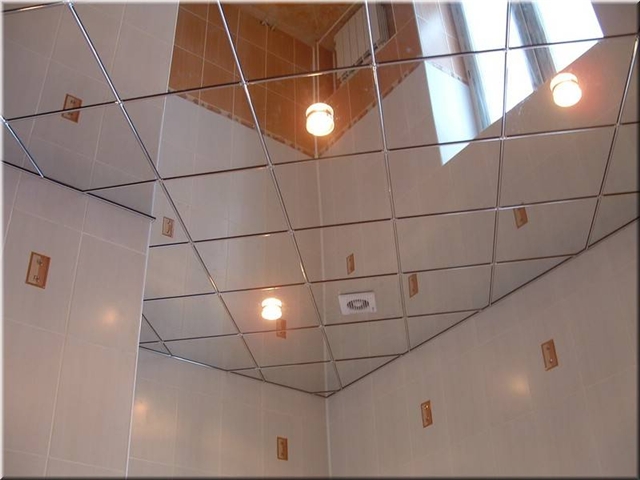
But as with many finishing materials, drywall also has its drawbacks. And the main one is that if the neighbors flood from above, then such a ceiling simply can not withstand the load. Well, such material should not be considered for bathrooms with low ceilings, it “eats” the space, but if you really want to use drywall, you should contact the designer, and this is an additional cost.
Stretch ceiling
If you want to have a smooth and visually light ceiling, you should order the installation of stretch material, which is an ideal solution for decorating such a room. But before making the final choice, it is worth weighing all the pros and cons of the stretch ceiling.
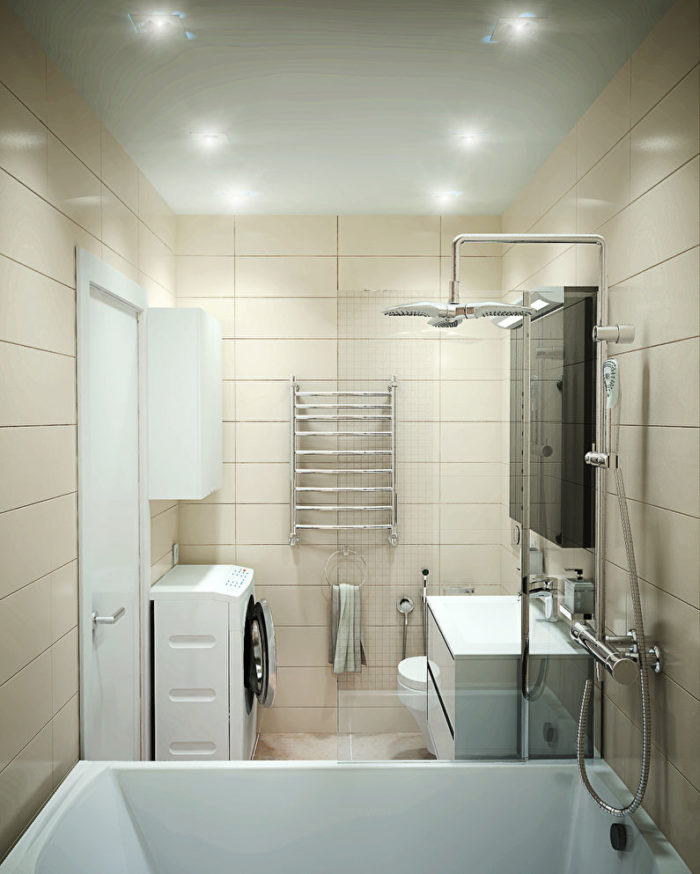
And it’s worth starting with the fact that the stretch ceiling “does not breathe” and if there is practically no ventilation in the bathroom, then you should immediately abandon such an idea. The thing is that the space between the ceiling and the canvas is an unventilated area, which means that the formation of fungus cannot be avoided. It cannot be washed, and even if the ceiling is dark and the fungus is not visible, this does not mean that it does not emit toxins that will poison others.
If water leaks from above, then the stretch ceiling can withstand a large amount of water.
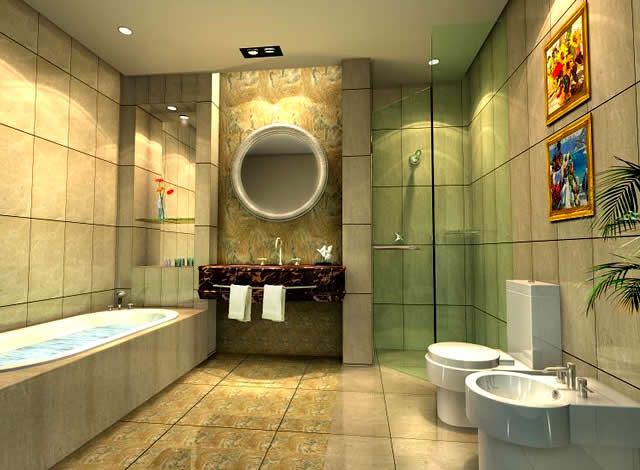
But if everything is fine in the bathroom with ventilation, then you can safely choose this type of finish, especially since the drawbacks of the stretch ceiling are over, the pros begin:
- durability and reliability;
- practicality;
- aesthetics;
- moisture resistance;
- wide color gamut.
If we talk about safety from an environmental point of view, many believe that since PVC is plastic, it means it releases toxins. Indeed, phenol is included in the composition of the material, but it is dangerous only with strong heating. If there is no plan to heat the ceiling with a construction hairdryer or hold it over a gas stove, then you should not worry about safety. It is also worth noting that both PVC film and fabric are suitable for the bathroom. You can verify this if you read the reviews and see the photos before and after finishing the bathroom.

Also, according to designers, choosing a finishing material for the ceiling is based on the area and height of the room itself. For a bathroom with low ceilings, tiling or paint is suitable. For a large room with high ceilings, you can consider options for stretch technology and construction of drywall.

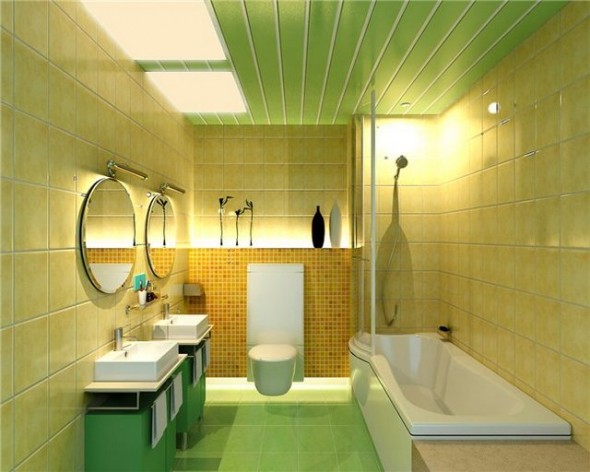
Alas, no comments yet. Be the first!